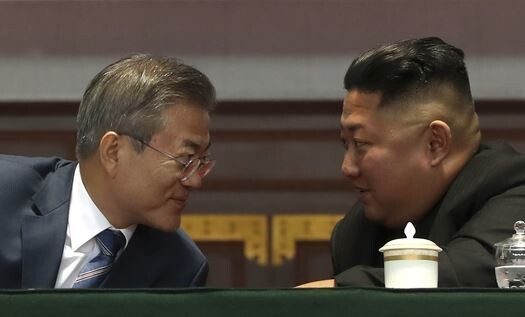hankyoreh
Links to other country sites 다른 나라 사이트 링크
Rodong Sinmun varies its use of official titles for Kim Jong-un depending on political situation

① “Comrade Kim Jong-un, the supreme leader of our party, state, and armed forces as Chairman of the Workers’ Party of Korea and Chairman of the State Affairs Commission of the Democratic People’s Republic of Korea”
② “Comrade Kim Jong-un, the supreme leader of our party, state, and armed forces as Chairman of the Workers’ Party of Korea, Chairman of the State Affairs Commission of the Democratic People’s Republic of Korea, and Supreme Commander of the Korean People’s Army”
One title appears in the second description but not the first – that of “Supreme Commander of the Korean People’s Army.” The first description comes from a front-page article published in the Sept. 21 edition of the Rodong Sinmun, the newspaper of the Workers’ Party of Korea (WPK) Central Committee, reporting on Kim’s visit to Cheonji (Heaven Lake) at Mount Baekdu with South Korean President Moon Jae-in. The second one comes from another Rodong Sinmun article on Sept. 9 about Kim’s visit to Kumsusan Palace of the Sun.
When is the “Supreme Commander of the Korean People’s Army” title used, and when is it omitted? A look at past Rodong Sinmun articles shows a kind of “rule” operating on this question.
In reports about Kim’s summit, the first description is used without reference to his status as KPA Supreme Commander. This was the case without exception for reports on all three inter-Korean summits between President Moon and Kim, as well as the three summits between Kim and Chinese President Xi Jinping. The second description is used in reference to Kim’s on-the-spot guidance and other domestic events.
The rule does not yet apply 100 percent of the time. Reports on the June 12 North Korea-US summit included a mix of the first and second descriptions. The two descriptions have also both been used in reports on Kim’s non-summit meetings with major figures from other countries.
A former South Korean senior official acquainted with “reading” the North offered an explanation on the use of titles in the North Korean press.
“It seems to reflect the fact that while ‘Workers’ Party of Korea Chairman’ and ‘DPRK State Affairs Commission Chairman’ are existing institutions and titles, ‘Supreme Commander of the Korean People’s Army’ is not,” the former official said. Indeed, North Korea does not have an actual “KPA Supreme Command” – which means “Supreme Commander” is merely a political title without institutional backing.
Different titles for North Korea’s first ladyOther rules were identified with the titles used for Kim’s wife Ri Sol-ju, who is referred to as “Madame Ri Sol-ju” in summit-related reporting and “Comrade Ri Sol-ju” in reports on domestic events. Rodong Sinmun articles on the Apr. 27 and Sept. 18–20 inter-Korean summits included references to “Comrade Kim Jong-un and Madame Ri Sol-ju.”
In contrast, an article on the first and second pages of the newspaper’s July 26 edition about Kim’s on-the-spot guidance visits to the Songdowon General Foodstuff Factory and Wonsan Disabled Soldiers’ Bag Factory contained a reference to
“Comrade Kim Jong-un and Comrade Ri Sol-ju.” Contrary to media reports suggesting Ri’s titled has been changed from “Comrade” to “Madame” or the reverse, the two titles appear to be used in distinct contexts.
By Lee Je-hun, senior staff writer
Please direct comments or questions to [english@hani.co.kr]

Editorial・opinion
![[Column] Has Korea, too, crossed the Rubicon on China? [Column] Has Korea, too, crossed the Rubicon on China?](https://flexible.img.hani.co.kr/flexible/normal/500/300/imgdb/original/2024/0419/9317135153409185.jpg) [Column] Has Korea, too, crossed the Rubicon on China?
[Column] Has Korea, too, crossed the Rubicon on China?![[Correspondent’s column] In Japan’s alliance with US, echoes of its past alliances with UK [Correspondent’s column] In Japan’s alliance with US, echoes of its past alliances with UK](https://flexible.img.hani.co.kr/flexible/normal/500/300/imgdb/original/2024/0419/2317135166563519.jpg) [Correspondent’s column] In Japan’s alliance with US, echoes of its past alliances with UK
[Correspondent’s column] In Japan’s alliance with US, echoes of its past alliances with UK- [Editorial] Does Yoon think the Korean public is wrong?
- [Editorial] As it bolsters its alliance with US, Japan must be accountable for past
- [Guest essay] Amending the Constitution is Yoon’s key to leaving office in public’s good graces
- [Editorial] 10 years on, lessons of Sewol tragedy must never be forgotten
- [Column] A death blow to Korea’s prosecutor politics
- [Correspondent’s column] The US and the end of Japanese pacifism
- [Guest essay] How Korea turned its trainee doctors into monsters
- [Guest essay] As someone who helped forge Seoul-Moscow ties, their status today troubles me
Most viewed articles
- 1[Column] The clock is ticking for Korea’s first lady
- 2[Correspondent’s column] In Japan’s alliance with US, echoes of its past alliances with UK
- 3After 2 months of delayed, denied medical care, Koreans worry worst may be yet to come
- 4[Column] Has Korea, too, crossed the Rubicon on China?
- 5[Editorial] When the choice is kids or career, Korea will never overcome birth rate woes
- 6Samsung barricades office as unionized workers strike for better conditions
- 7US exploring options for monitoring N. Korean sanctions beyond UN, says envoy
- 8US overtakes China as Korea’s top export market, prompting trade sanction jitters
- 9[Photo] Smile ambassador, you’re on camera
- 10Hong Se-hwa, voice for tolerance whose memoir of exile touched a chord, dies at 76